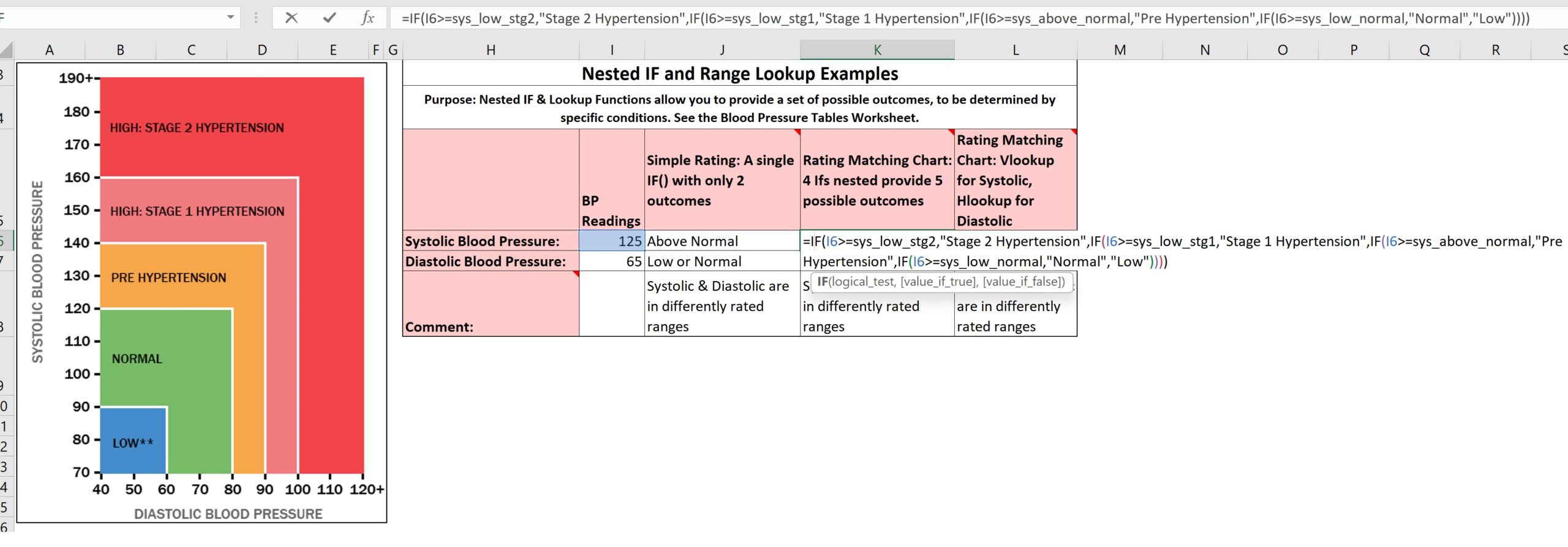Transcript(click to view)
Suzanne here. Welcome to Excel Intuition’s Nested If example 1 video. In this case we are going to look at the Nested If Range Lookups worksheet. And on this worksheet we have an illustration of a Blood Pressure
Ratings Table. This table categorizes different readings into different rating categories for the Systolic blood pressure and the Diastolic blood pressure. So, we’ve got this Low range, the Normal range, on up to the highest one Illustrated is the Stage 2 Hypertension. And we’ve got this column in this table asking us to provide five possible outcomes: either Low, Normal, Pre-Hypertension, Stage 1 Hypertension, or Stage 2 Hypertension for both Systolic Blood Pressure and the Diastolic Blood Pressure.
So basically, we need, we don’t have to do any tricky testing, because we’re basically just going down
a table of values. We’re testing first at the top of the table, for the reading being >= (greater than or equal to) the lowest value in Stage 2. If that’s true, then we end, our IF() function will be completed, and we’ll have the outcome: “Stage 2 Hypertension”, else the False argument to the first IF() is a whole other IF() function that contains other IF() functions. But then, the second test that will be conducted, will be testing, is it in this Stage 1 area? Is it >= (greater than or equal to) Low Stage 1? We don’t have to test, Is it < (less than) Stage 2? Because we wouldn’t have gotten to this IF() Function if it wasn’t. So, if it’s >= (greater than or equal to) Low Stage 1, then we end with this outcome: “Stage 1 Hypertension.”
However, if this test is NOT TRUE, we go on to this test: Is it above Normal? Which would put it in the “Pre-Hypertension Range.” Then that would be our outcome.
And the last test we do, is we ask: Is it >= (greater than or equal to) the Low Normal value? If that’s true, then our outcome is going to be “Normal,” otherwise our outcome is going to be “Low.”
And we have a parallel to this
that looks at the value of the Diastolic Blood Pressure and gives us, checks for the same different outcomes, starting with the highest range, going down, with the “Low” being the final possible Value-If-False argument.
Thank you.
Ratings Table. This table categorizes different readings into different rating categories for the Systolic blood pressure and the Diastolic blood pressure. So, we’ve got this Low range, the Normal range, on up to the highest one Illustrated is the Stage 2 Hypertension. And we’ve got this column in this table asking us to provide five possible outcomes: either Low, Normal, Pre-Hypertension, Stage 1 Hypertension, or Stage 2 Hypertension for both Systolic Blood Pressure and the Diastolic Blood Pressure.
So basically, we need, we don’t have to do any tricky testing, because we’re basically just going down
a table of values. We’re testing first at the top of the table, for the reading being >= (greater than or equal to) the lowest value in Stage 2. If that’s true, then we end, our IF() function will be completed, and we’ll have the outcome: “Stage 2 Hypertension”, else the False argument to the first IF() is a whole other IF() function that contains other IF() functions. But then, the second test that will be conducted, will be testing, is it in this Stage 1 area? Is it >= (greater than or equal to) Low Stage 1? We don’t have to test, Is it < (less than) Stage 2? Because we wouldn’t have gotten to this IF() Function if it wasn’t. So, if it’s >= (greater than or equal to) Low Stage 1, then we end with this outcome: “Stage 1 Hypertension.”
However, if this test is NOT TRUE, we go on to this test: Is it above Normal? Which would put it in the “Pre-Hypertension Range.” Then that would be our outcome.
And the last test we do, is we ask: Is it >= (greater than or equal to) the Low Normal value? If that’s true, then our outcome is going to be “Normal,” otherwise our outcome is going to be “Low.”
And we have a parallel to this
that looks at the value of the Diastolic Blood Pressure and gives us, checks for the same different outcomes, starting with the highest range, going down, with the “Low” being the final possible Value-If-False argument.
Thank you.

